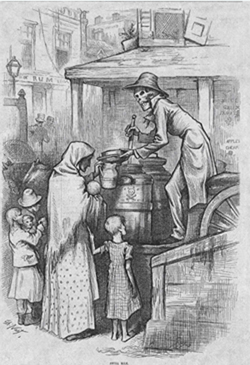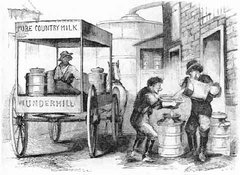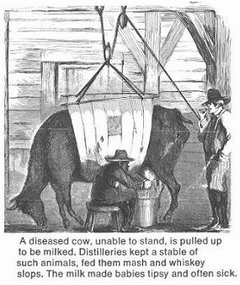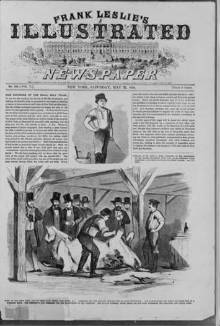 The following is an article from Uncle John's Giant 10th Anniversary Bathroom Reader.
The following is an article from Uncle John's Giant 10th Anniversary Bathroom Reader."Milk and kids" are virtually synonymous in our culture with "good health." But that wasn't always the case. Until the early 1900s, milk was often adulterated with foreign substances, taken from sick cows, or mis-handled during milking and storage. As a result, it was often host to tuberculosis, cholera, typhoid fever, and other life-threatening diseases. But few people knew that the milk made them sick. It wasn't until the late 19th century, when scientists began to understand germ theory, that they realized diseases were being transferred through milk -and that they could do something to eliminate the hazard. Here's a fascinating but little-known story from American history.
THE GOOD OLD DAYS
In the days before refrigeration, farmers who lived near towns delivered milk the old-fashioned way: they brought a cow into town and went door to door looking for customers. Anyone who wanted milk could step out into the street with a pitcher or a bucket, and watch the farmer milk the cow right before their eyes.
Since customers were standing only a few feet away, it paid for the farmer to take good care of his cows. Nobody wanted to buy milk from a beast that looked dirty, mistreated, or sick. So although there was a risk of buying bad milk, it was kept to a minimum.
City Slickers
 But in cities, where door-to-door cow service wasn't practical or possible, buying milk was another matter. "Milks sellers" acted as middlemen between farmers and townspeople. Like used car dealers today, they were widely mistrusted and said to possess "neither character, nor decency of manner, nor cleanliness." Whether or not the reputation was deserved, they were notorious for diluting milk with water to increase profits. People said their milk came from "black cows," the black cast iron pumps that provided towns with drinking water. And if the pump was broken, horse troughs were always a handy source of water.
But in cities, where door-to-door cow service wasn't practical or possible, buying milk was another matter. "Milks sellers" acted as middlemen between farmers and townspeople. Like used car dealers today, they were widely mistrusted and said to possess "neither character, nor decency of manner, nor cleanliness." Whether or not the reputation was deserved, they were notorious for diluting milk with water to increase profits. People said their milk came from "black cows," the black cast iron pumps that provided towns with drinking water. And if the pump was broken, horse troughs were always a handy source of water.Although it actually spread serious diseases, water-down milk was seen as more of an annoyance than a health hazard, and nothing much was done about it. It wasn't until the 1840s that scandals in the liquor industry led to the first demands for milk reform.
THE SWILL MILK SCANDALS
In the mid-1800s, it was common for whiskey and other distillers to run dairy and beef businesses on the side. The manufacture of grain alcohol require huge amounts of corn, rye, and other fresh grains, which are cooked into a mash and then distilled. Once that distillation is complete, the remaining "swill" can be discarded... or, as the distiller discovered, it can be fed to cows.
Profit, not quality, was the priority with "swill herds." As a result, conditions in many distillery-owned dairies were atrocious. The cows spent their entire lives tied up in tiny pens, which were rarely cleaned. They received no food other than the swill -and no fresh water at all, since distillers though there was already plenty of water in the swill.
 Spoiled Milk
Spoiled MilkWith no exercise, no real food, and no water, even the hardiest cattle sickened and died in about six months. The failing herds were milked daily until the very end; when a cow became too weak to stand on its own, it was hoisted upright with ropes so that it cold be milked until it died.
Milk produced by swill herds, as muckraking journalist Robert Hartley wrote in 1842, was "very thin, and of a pale bluish color," the kind nobody in their right mind would buy. So distillers added flour, starch, chalk, plaster of Paris, or anything else they could get away with to make the milk look healthy. This adulteration only increased the amount of bacteria in milk that was already virtually undrinkable.
TAKING NOTICE
The toll that adulterated milk took on public health was severe: in New York City, where five million gallons of swill milk were produced and sold each year, the mortality rate for children under five tripled between 1843 and 1856.
 No one knew for sure what was causing the child mortality rate to soar, and there was probably no single cause. But people began to suspect that bad milk was at least partially to blame. In May 1858, Frank Leslie's Illustrated Newspaper, one of the most popular journals of the day, published a series of articles describing in graphic detail the conditions in some of New York's swill dairies.
No one knew for sure what was causing the child mortality rate to soar, and there was probably no single cause. But people began to suspect that bad milk was at least partially to blame. In May 1858, Frank Leslie's Illustrated Newspaper, one of the most popular journals of the day, published a series of articles describing in graphic detail the conditions in some of New York's swill dairies.REFORMS
Public exposure had a devastating impact on the industry. Some distilleries got out of the milk business entirely; other cleaned up their act. Those that remained were forced out of business in 1862, when the state of New York outlawed "crowded or unhealthy conditions" in the dairy industry. Two years later, the state outlawed the industry outright, declaring that "any milk that is obtained from animals fed on distillery waste, usually called will, is hereby declared to be impure and unwholesome."
Several other state followed suit, including Massachusetts, Pennsylvania, Illinois, Kentucky, and Indiana. As they took action, the spiraling infant death rate in the U.S. leveled off -and even began to decline. But there was plenty of work left to be done to ensure that milk was safe.
See also: part two of The Fight for Safe Milk: Pasteurization.
_____________________________
 Reprinted with permission from Uncle John's Giant 10th Anniversary Bathroom Reader, which comes packed with 504 pages of great stories.
Reprinted with permission from Uncle John's Giant 10th Anniversary Bathroom Reader, which comes packed with 504 pages of great stories.Since 1988, the Bathroom Reader Institute had published a series of popular books containing irresistible bits of trivia and obscure yet fascinating facts.
If you like Neatorama, you'll love the Bathroom Reader Institute's books - check 'em out!







Check out the industry standards on cows today:
http://www.mercyforanimals.org/dairy_and_veal.asp
http://www.youtube.com/watch?v=oocLFKdIirw
http://www.associatedcontent.com/article/313303/the_ugly_side_of_dairy_factory_farming.html